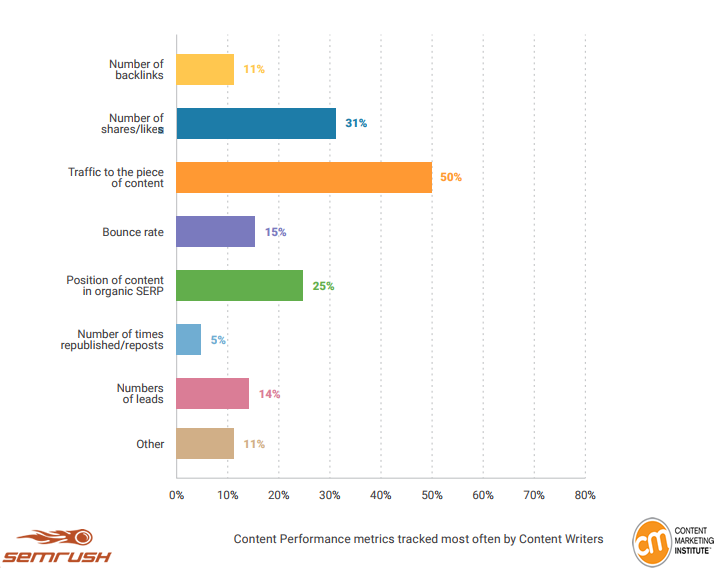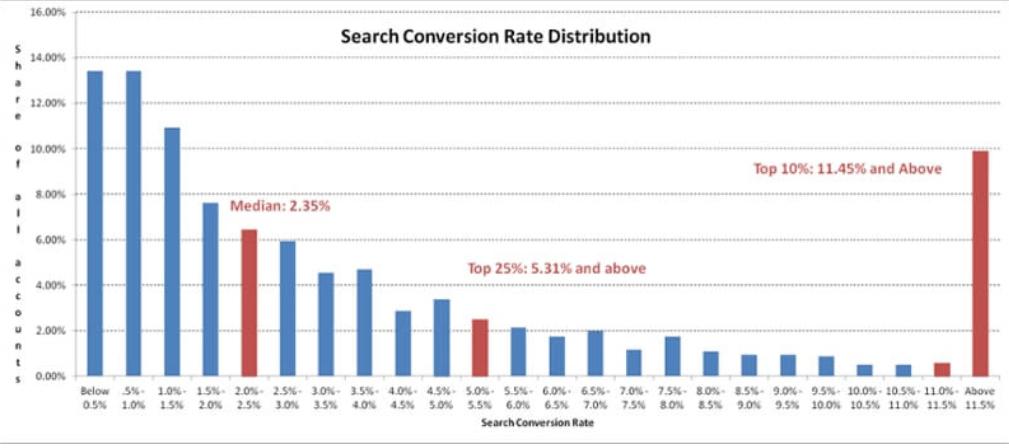4 Content Performance Metrics to Improve Your Content Marketing ROI
Content marketing is one of the most used digital marketing areas today. Almost 91% of businesses are using content to grow online.
Quick Links
So, if you are also producing amazing content for your audience, but results are not what you have expected? There is nothing wrong with your content.
The problem is here with your content monitoring strategy, or we can say no strategy.
Mostly, businesses are so busy creating outstanding content that they forget to measure content marketing ROI.
Therefore, only 6% of marketers can say that they have matured content marketing strategies.
So, if you are a small business planning to drive qualified leads and revenue from your content marketing efforts, you better start measuring your content performance. And for your ease, we have already shortlisted the content performance metrics that you must measure for a robust content marketing strategy.
Let’s get started.
Things to Consider Before Measuring Content Performance
Before measuring your content performance, you have to consider the following things:
Objectives and KPIs
The first step to measuring content performance is to decide objectives and key performance indicators (KPIs) for each marketing campaign. Objectives and KPIs help you decide which content performance metrics can work better for you.
For instance, if you have launched an email marketing campaign to generate more clicks on the product landing page, measure the number of unique visitors on the said web page.
You simply have to ask, “why are you creating a certain piece of content” and you will find objectives and KPIs to measure the performance.
Select the right marketing tools
After deciding on objectives, you need to acquire the right marketing tools to measure metrics. Manually it is impossible to track and analyze performance metrics on different marketing channels.
Thus, you have to find a performance measurement tool that can provide accurate results based on your objectives. For example, if you want to know your organic and paid social media campaigns’ performance, Social Status is the best tool to create automatic multi-channel reports.
Tracking over your competitors is also a good practice. If you want to track your competitors’ social media content performance over Instagram and Facebook then you can leverage best IG competitor tracking tools.
On the other hand, if you need to combine data collected from different business solutions in a place, you can use Coupler. This tool can consolidate data from HubSpot, Shopify, Slack, and other tools.
Streamline your team
You need to educate your whole team about your content marketing campaign objectives and the tools you will use. Getting your team on the same page helps to measure, analyze and drive desired results from your content.
Top 4 Content Performance Metrics
Measuring your content performance will help you spot weak areas in your content marketing strategy and revive them before it’s too late. But for that, you need accurate content performance metrics and tools.

Here are the top content performance metrics that every business should measure:
1. Traffic Metrics
Traffic is the main reason you are marketing a brand online. You are making all efforts to write a perfect blog, so it can generate traffic.
Traffic landing on your website helps you understand how many people are interested in your brand and willing to purchase from you. But traffic is a very generic term. Numerous metrics are used to measure traffic landing on your content, such as:
- Pageviews: This metric shows the number of times a particular web page was visited on your website. Pageviews provide a basic understanding of how well your content performed compared to other publications. It will tell you about hot topics that people visit more often on your website.
- Users: It indicates the total number of users who visited your website or blogs in a particular period. This metric will provide a complete overview of your website visitors.
- New and Returning users: It is good to have balanced new and returning users on your website. The number of new users indicates leads generated by your content, and the returning metric shows how many people are enjoying your content and revisiting it.
- Average Time on Page: This performance metric helps you understand whether people are taking time to read your blogs or simply skimming through them. Using this information, you can know which content format and style has improved the user’s time on the page.
- Bounce Rate: It is a single session metric. When a user lands on your site, but without clicking or spending time, they leave. The higher bounce rate indicates that something is not right with your website that’s sending people away. It could be a problem with the content or layout of your website. To fix this, try to make the content more attractive and invite your users to interact with it. For example, you could use interactive animation to reduce the bounce rate on your website.
- Pages per Session: This metric indicates the average number of views a page received during a particular session. This information will help you see whether your content is engaging enough to drive traffic to other pages or not.
- Traffic Sources: If you promote your content on multiple channels, this metric will show you which channel has brought more traffic. This way, you can invest in the sources that bring more traffic to your website.
Best Website Traffic Monitoring Tools: Google Analytics, Crazy Egg, Kissmetrics, ClickTale, etc.
2. Engagement Metrics
Engagement is another important content performance measurement metric. It helps you understand whether people are interacting with your content and taking action on it.
Social media is the best way to understand engagement coming from your content via likes, shares, post views, etc. Besides this, you can evaluate your content engagement through these metrics:
- Brand Mentions: With this metric, you can know how many people are talking about your brand on social media. It will help to Increase brand awarness and boost reputation, which directly impact your SEO score.
- Email Signups: If you use emails to distribute and promote your content, the number of people who signed up for your emails is a direct engagement metric.
- CTR: Click-through rate on your Google display and social media ads show the total number of users who have clicked on your ads and landed on your website. This metric is useful to determine engagement on your paid content campaigns.
- Likes, Shares, and Comments: The number of shares, likes, and comments on your social media content is a simple way to understand the engagement level of your content.
Best Content Engagement Measurement Tools: Sixads, Snov.io, Semrush, Buffer, etc.
3. Conversion Metrics
Conversion is one of the important metrics for B2B marketers. The main objective of the B2B content marketing strategy is to generate leads and turn them into prospective customers. Therefore, it is extremely important for B2B content marketers to evaluate conversion rates.
The conversion is a metric that can’t be calculated alone. To determine the average conversion rate, you have to measure your content performance over a significant period. It is shown that the median conversion rate across different industries is 2.35%.

Here you can use these metrics to measure the conversion rate of your content:
- New Leads: The number of people who requested a demo visited your price page or made sales query calls is the number of new leads generated by your content over the period. This metric helps you identify new leads and nurture them into the sales funnel.
- SQL: Apart from bounce rate and page views, it is essential for B2B marketers to evaluate the sales qualified leads metric. This helps to understand the leads that are ready to become your customers.
- Custom Events: You can organize an event around your content to measure the exact conversion rate. For example, you can publish gated content like e-books or downloadable case studies on your website to check how many people are willing to download your content. This will provide information about the people who are engaged with your brand.
- Revenue: There is no direct content performance measurement metric other than revenue. By evaluating revenue generated via content during a specific period, you can understand the conversion rate of your content marketing strategy.
Best Conversion Rate Measurement Tools: CloudTalk, SimilarWeb, Compete, Owler, Alexa, etc.
4. SEO Metrics
Search engine optimization is one of the primary roles of content. Usually, content is published on a website to target relevant keywords so search engines can rank your website on them. SEO metrics are important for the organic growth of your business online.
Using these SEO metrics, you can better create search engine friendly content:
- Organic Traffic: This metric shows how many visitors are brought to your website by search engines. The lower number will indicate that your website is not properly optimized for search engines, and you need to make some changes in your content to improve your organic traffic rate.
- Dwell Time: It shows the time a visitor spends on your web page before going back to search results. The negative number will show that people are bouncing off your website, and you need to make some efforts to retain them for a longer period.
- Backlinks: It is one of the most important Google ranking factors. Therefore, you cannot ignore backlinks while measuring the performance of your content. You should eliminate all spamming backlinks and calculate the number of unique domains and the quality of referring domains.
- Keyword Rankings: Using a dedicated rank tracker you can see how high performing and relevant your targeted keywords are to search queries and buyers’ intent.
Best SEO Analytical Tools: Google Search Console, Ahrefs, Keyword Planner, Moz Pro, etc.
Let’s Measure Content’s Performance
No matter how amazing a content marketing strategy or team you have, you cannot grow online without measuring the performance of your content in real-time.
You will simply waste your resources if you don’t measure your performance on time. Therefore, it is essential for marketers to measure the performance of their different content marketing campaigns using the right metrics.
We have already shared the must-measure content metrics and tools to do that. So, let’s not waste any more time and monitor your content growth now.
Why WooCommerce is the Best Choice for Your Online Store?
WooCommerce stands out as a top option for anyone looking to build an online store. This platform…
0 Comments8 Minutes
How to Use AI-Powered SEO Tools for WordPress eCommerce
SEO is a critical factor in the success of any e-commerce WordPress store. As competition…
0 Comments11 Minutes
Why Short-Form Videos Are the Future of Content Marketing
Your Instagram customers spend over 50% of their time watching short-form videos and reels. Rather…
0 Comments12 Minutes
The Role of Digital Marketing in Business Growth
Online marketing touches every aspect of a business, whether it is initiating the idea or for an…
0 Comments3 Minutes
AI Meets Authenticity: Balancing Automation and Human Touch in Content Marketing
Is your brand starting to sound like a robot? In a world where algorithms write faster than any…
0 Comments8 Minutes
Essential Tools for Enhancing Web Design and UX Hosting
Have you ever visited a website that felt slow, clunky, or confusing? A website that is poorly…
0 Comments11 Minutes
How a Mini Cart Transformed My Store’s Shopping Experience
Okay, real talk—running an online store is hard. You think you’ve got everything figured out, you…
0 Comments9 Minutes
Balancing Your Security Initiatives With Industry Compliance Requirements
Managing a business today comes with a number of daily battles that need to be fought. Resources…
0 Comments11 Minutes








